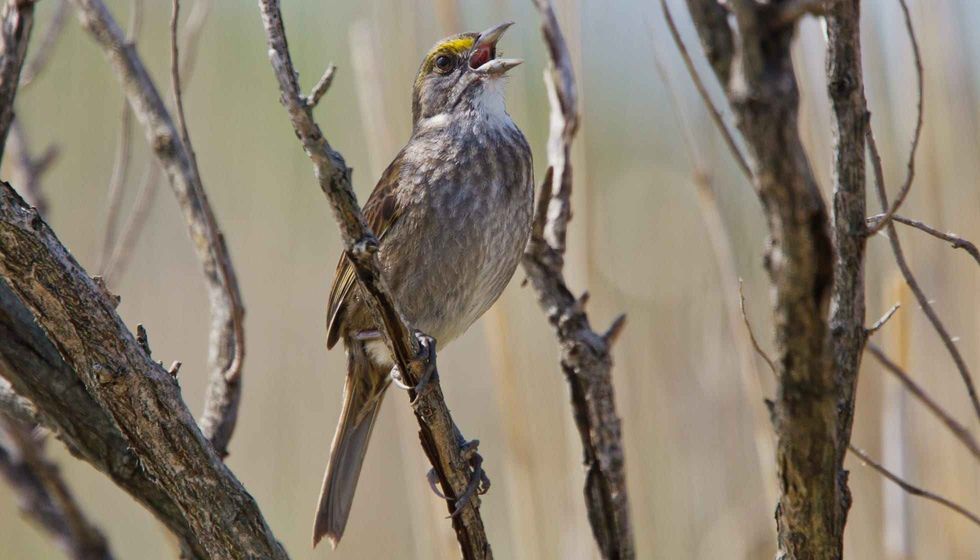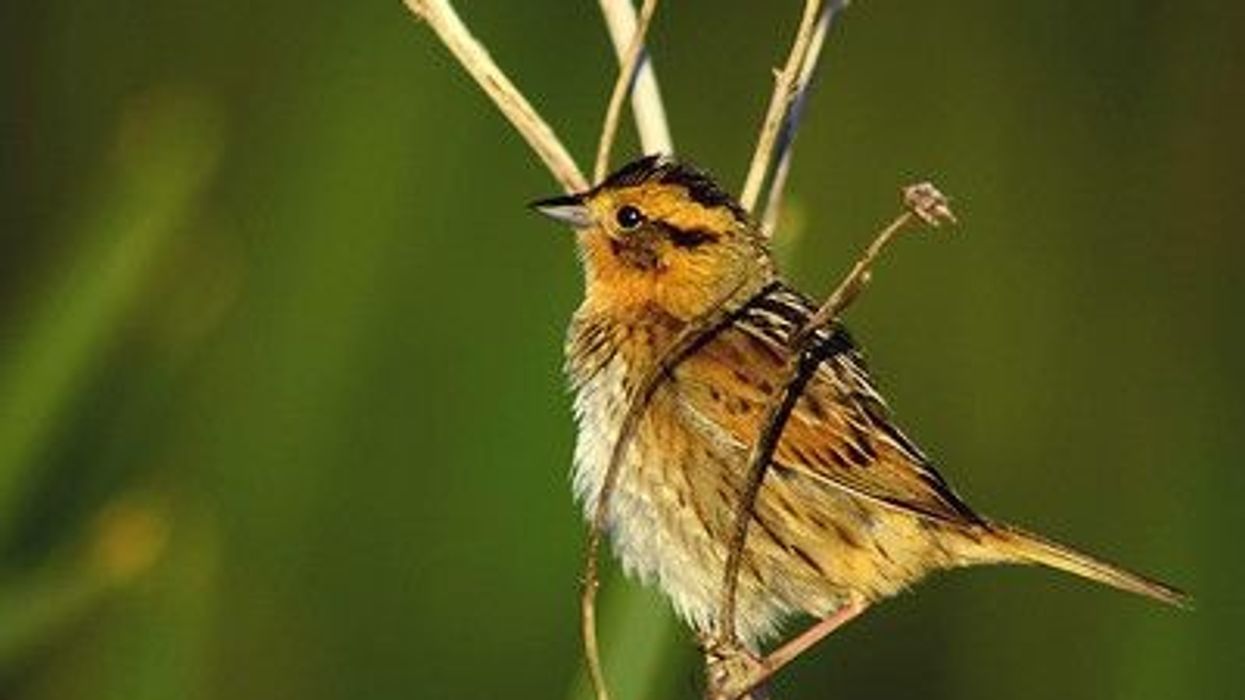Seaside sparrows are brown birds with dark plumage that inhabit tidal saltmarshes with abundant and varied vegetation. This habitat is helpful for both their nesting and dietary requirements.
They are quite territorial in their breeding areas but the subspecies are found grouped in a few places. They are found in a range of places from northeast Florida to North Carolina. They are also found in the marshes of the Atlantic Coast and along the Gulf Coast to Texas.
Due to habitat loss caused by an increase in sea levels, damage to vegetation distribution, and introduced contaminants in marsh areas of their breeding habitat caused by human activities, this bird is at risk. The U.S.
Fish and Wildlife Service and other wildlife management and conservation organizations are putting efforts in to map and protect all the at-risk subspecies of this bird.
The seaside sparrow (Ammospiza maritima) has many subspecies, each with subtle differences. The dusky seaside sparrow, Scott's seaside sparrow, and the Cape Sable seaside sparrow are all seaside sparrows.
If you like this article, please go through our facts about the chipping sparrow and the scarlet macaw.
Seaside Sparrow Interesting Facts
What type of animal is a seaside sparrow?
The seaside sparrow is a songbird and it is a partially migratory species. Its subspecies range across salt marshes, and the population is seldom found in other habitats. They are small dark passerine birds.
What class of animal does a seaside sparrow belong to?
The seaside sparrow belongs to the Aves class of the Passerellidae family. The scientific name of the seaside sparrow is Ammospiza maritima. Its subspecies are very similar, with a few subtle differences in their appearance and breeding habits.
How many seaside sparrows are there in the world?
The exact population of this bird species is unknown because of their difficult-to-access habitat marshes. These birds are widely found in abundance, but conservation measures are required for a few imperiled subspecies like the Cape Sable seaside sparrow. Also, the dusky seaside sparrow is extinct now sadly, showing the importance and need for these efforts.
Where does a seaside sparrow live?
Seaside sparrow subspecies are found in tidal marshes with dense vegetation and areas of marsh grass on the Atlantic Coast and the Gulf Coast to Texas and North Carolina, United States. The Cape Sable seaside sparrow is endemic to southern Florida. They are migratory species and migrate from northern regions to southern regions during their breeding season.
What is a seaside sparrow's habitat?
The seaside sparrow's habitat is mainly tidal, brackish salt marshes with a mosaic of creeks and multiple plant species such as black needle rush, saltmarsh rush, salt, and smooth cordgrass. Their habitat also includes bushes such as groundsel and succulents like glasswort and saltwort, as well as flowering plants.
All of these are helpful for their dietary requirements and nesting.
Who do seaside sparrows live with?
Seaside sparrow lives in small groups, and the subspecies are found together sharing their marsh habitat. However, they are territorial when it comes to nesting. Young fledglings also group near their nests which helps them stay safe from intruders.
How long does a seaside sparrow live?
The lifespan of an average seaside sparrow is around seven years. However, the longest lifespan on record of this bird is 10 years!
How do they reproduce?
The seaside sparrow reproduces by sexual reproduction. They partner for breeding in springtime. The male first approaches the female with a song, and the female reciprocates with the same song.
After this courtship ritual, the female builds a nest while the male guards the territory. Males have special songs to alert other males of their nesting territory and to chase away any intruders.
A brood consists of two to five eggs, and there may be two broods in a season. Both breeding partners incubate the eggs in the nest, which hatch in two weeks. The baby birds fly off after a month to be on their own.
What is their conservation status?
According to the IUCN Red List, the conservation status of a Cape Sable seaside sparrow (Ammospiza maritima mirabilis) is Endangered. The dusky seaside sparrow (Ammospiza maritima nigrescens) is now extinct.
This species, in general, is listed as Least Concern but they are at risk due to habitat loss (because of rising sea levels and surging storms), and other human activities which are damaging their habitat.
Seaside Sparrow Fun Facts
What do seaside sparrows look like?
They are brown birds with a yellow tinge over their face. Males are a brighter color than females. With a bluffy chest, they are medium-sized hefty-looking sparrows with long bills. They have streaks of dark brown on their back and a gray light-colored underside with rusty wing patches.

*Please note that this is an image of a Greenback Sparrow, not a Seaside Sparrow specifically. If you have a royalty-free image of a Seaside Sparrow, then please let us know at hello@kidadl.com
How cute are they?
They are songbirds and they are especially cute when they are in flight. With dark gray and brown plumage, this bird blends into its habitat. These sparrows, when they arrive, indicate the arrival of spring in tidal areas, which is a nice extra touch!
How do they communicate?
Like any aerial semaphore signalers, these birds communicate with physical gestures using their wings and tail. When there is an intruder, they shiver their wings and spread their tails to threaten them away or pick up a piece of grass with their bill.
Males raise their one wing to attract a mate during the breeding season. They are songbirds and so they also have lots of vocal cues to signal each other. For example, females make alarm calls to alert their partner of an intruder.
How big is a seaside sparrow?
They are small chunky birds that are 5 - 6 in (1.97-2.36 cm) in length with a wingspan of 7.5 in (19.05 cm). They have a substantial long bill and large feet.
How fast can a seaside sparrow fly?
The speed of this particular species is not known, but in general, sparrows fly more or less at 40 mph (64 kph).
How much does a seaside sparrow weigh?
A fully grown seaside sparrow weighs around 0.7 - 1 oz (19.8-28.3 g).
What are the male and female names of the species?
No specific names are given to males and females of the seaside sparrow species. Interestingly, a group of seaside sparrows is known as a picnic of sparrows!
What would you call a baby seaside sparrow?
A baby seaside sparrow is known as a hatchling. Each hatchling stays in the nest for around 10 days. They then become young fledglings, who stay near the nesting sites for around another 15 days before flying off.
What do they eat?
Tiny insects and seeds make up the majority of this bird's diet. Insects like grasshoppers, caterpillars, spiders, and beetles are eaten along with small crabs, snails, and other marine worms, which are an essential source of protein during their breeding season. Seeds, including cordgrass and saltbush, are their main dietary stuff during winter and fall.
Are they aggressive?
Not really. These are lovely songbirds, the only time they can be aggressive is when they are territorial about their nesting sites.
Would they make a good pet?
This species is a group of migratory birds so they are not kept as pets.
Did you know...
The U.S. Fish and Wildlife Service is taking measures to protect the endangered subspecies of the seaside sparrow, including the management of national wildlife refuges.
It also collaborates with other conservation groups to protect and enhance the habitat of all endangered bird and fish species. Conservationists are currently working on a range map and field guide to protect the nesting and breeding sites of the population of seaside sparrows.
Why did the dusky seaside sparrow go extinct?
Dusky seaside sparrows went extinct in 1987. This happened because of contamination of its food chain due to pest control measures that were put in place to control the mosquito population in the marshes of Florida.
What are some special features of the seaside sparrow?
One of the unique features of a seaside sparrow is that it can drink saltwater. Thanks to this ability, they play a crucial role in balancing their ecosystem. They also have a special chirping characteristic to their song style.
Here at Kidadl, we have carefully created lots of interesting family-friendly animal facts for everyone to discover! Learn more about some other birds, including the least tern or the killdeer.
You can even occupy yourself at home by drawing one on our seaside sparrow coloring pages.










